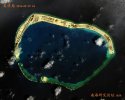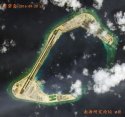The Chinese have always been great builders by tradition & history (e.g. Great Wall of China etc.). However, let's hope the building/assembling of China's floating nuclear plant on Spratlys will be real safe according to international standards. If in future there are leakages or damages, it could cause Disaster to close-by/neighbouring countries/territories. We hope nothing like the Japanese disaster on Fukishuma (sic) would happen.
You are using an out of date browser. It may not display this or other websites correctly.
You should upgrade or use an alternative browser.
You should upgrade or use an alternative browser.
PLAN SCS Bases/Islands/Vessels (Not a Strategy Page)
- Thread starter lilzz
- Start date
Nuclear reactors are very safe in general.The Chinese have always been great builders by tradition & history (e.g. Great Wall of China etc.). However, let's hope the building/assembling of China's floating nuclear plant on Spratlys will be real safe according to international standards. If in future there are leakages or damages, it could cause Disaster to close-by/neighbouring countries/territories. We hope nothing like the Japanese disaster on Fukishuma (sic) would happen.
Two of the four reactors that had major accidents (LP-1 and Three Miles Island) were built before there was a man on the moon.
The Chernobyl accident was caused by lack of communication and wrong procedures which both are human error.
The Fukushima reactor was destoryed by a tsunami, one of the greatest forces of nature, the reactor was built with a bad choice of location. (Actually almost the entirety of Japan is unsuitable for reactors as the chances of earthquake and tsunami are too high) Also 15891+ was killed by the Tsunami, none by the reactor or radiation.
IMO there's nothing to worry about.
Hendrik_2000
Lieutenant General
Except South China Sea is typhoon prone area . And you can never predict what mother nature will do next.
Just like Fukushima.
Shutting down take a long time and you still has to deal with waste heat. Maybe low temp reactor like Thorium cycle,or the pebble ball reactor will do
Unless they towed the floating plant to safe area before the storm hit. But that take a long time and typically you can never predict precisely the path of typhoon
Just like Fukushima.
Shutting down take a long time and you still has to deal with waste heat. Maybe low temp reactor like Thorium cycle,or the pebble ball reactor will do
Unless they towed the floating plant to safe area before the storm hit. But that take a long time and typically you can never predict precisely the path of typhoon
Last edited:
Plenty of cooling water will be available. Thorium Molten Salt and pebble bed reactors are high temperature types which means that a larger part of energy generated ends up as electricity and a smaller part as waste heat. After shut down cooling will be easier than in old fashioned PWR's and BWR's.Except South China Sea is typhoon prone area . And you can never predict what mother nature will do next.
Just like Fukushima.
Shutting down take a long time and you still has to deal with waste heat. Maybe low temp reactor like Thorium cycle,or the pebble ball reactor will do
Unless they towed the floating plant to safe area before the storm hit. But that take a long time and typically you can never predict precisely the path of typhoon
2016-10-06 09:31 | Xinhua | Editor: Feng Shuang

A worker feeds a sea turtle at a protection station in Sansha, Hainan province, in July
(Photo: Hainan Daily/Zheng Mao)
Sansha mayor Xiao Jie said the city intents to build a sea turtle refuge that integrates such functions as hatching, release and research.
The center is expected to attract experts, volunteers and environmental organizations to Sansha, he said.
Sansha City was officially established in 2012 to administer the Xisha, Zhongsha and Nansha islands and their surrounding waters in the South China Sea.
Over the past four years, the city's environment has seen great improvements thanks to the new garbage collection system, sewage treatment plants and afforestation efforts.
Some sea turtle protection stations have already been set up on the city's islands. This year, over 50 nests of baby turtles were hatched and released to the sea off the Qilianyu Islands. The island of Jinqing has released 80 baby turtles to the sea.
The city is also considering establishing video observation stations on some uninhabited islands and reefs.
Most importantly it has to attract sea turtles.
2016-10-06 09:31 | Xinhua | Editor: Feng Shuang
View attachment 32858Sansha City plans to set up a sea turtle protection center to promote marine bio-diversity conservation in the region, authorities said Wednesday.
A worker feeds a sea turtle at a protection station in Sansha, Hainan province, in July
(Photo: Hainan Daily/Zheng Mao)
Sansha mayor Xiao Jie said the city intents to build a sea turtle refuge that integrates such functions as hatching, release and research.
The center is expected to attract experts, volunteers and environmental organizations to Sansha, he said.
Sansha City was officially established in 2012 to administer the Xisha, Zhongsha and Nansha islands and their surrounding waters in the South China Sea.
Over the past four years, the city's environment has seen great improvements thanks to the new garbage collection system, sewage treatment plants and afforestation efforts.
Some sea turtle protection stations have already been set up on the city's islands. This year, over 50 nests of baby turtles were hatched and released to the sea off the Qilianyu Islands. The island of Jinqing has released 80 baby turtles to the sea.
The city is also considering establishing video observation stations on some uninhabited islands and reefs.
Last edited:
Hendrik_2000
Lieutenant General
Sansha Garrison and Militia
kwaigonegin
Colonel
Nuclear reactors are very safe in general.
Two of the four reactors that had major accidents (LP-1 and Three Miles Island) were built before there was a man on the moon.
The Chernobyl accident was caused by lack of communication and wrong procedures which both are human error.
The Fukushima reactor was destoryed by a tsunami, one of the greatest forces of nature, the reactor was built with a bad choice of location. (Actually almost the entirety of Japan is unsuitable for reactors as the chances of earthquake and tsunami are too high) Also 15891+ was killed by the Tsunami, none by the reactor or radiation.
IMO there's nothing to worry about.
Nuclear reactors may be 'safe' if built right however the impact and repercussions of any accidents be it man made or natural is exponentially worse and unlike any other types of energy sources a nuclear accident would make the place inhabitable for life for hundreds of years.
antiterror13
Brigadier
Most importantly it has to attract sea turtles.
Sea turtles will be back (to lay eggs) to where they hatched ...... strange phenomenon, but it is true



